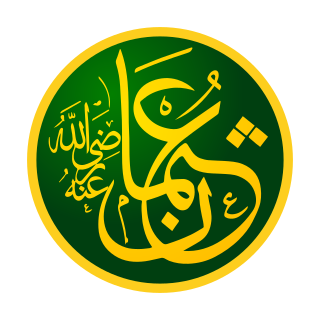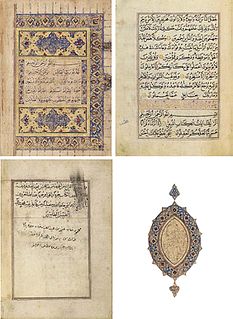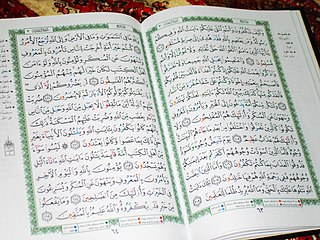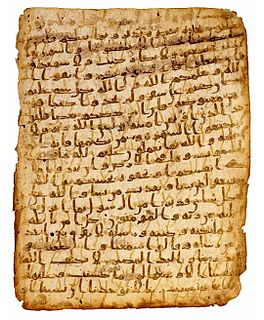
The Quran, also romanized Qur'an or Koran, is the central religious text of Islam, believed by Muslims to be a revelation from God (Allah). It is widely regarded as the finest work in classical Arabic literature. It is organized in 114 chapters, which consist of verses.

Uthman ibn Affan, also spelled by the Turkish and Persian rendering Osman, was the third Rashidun caliph, succeeding Umar ibn al-Khattab. He ruled for twelve years, the longest of all Rashidun caliphs, and the Rashidun Caliphate reached its greatest extent under Uthman. He is known for having ordered the compilation of the first standard version of the Quran. He was a prominent companion and son-in-law of Muhammad.

Kufic script is a style of Arabic script that gained prominence early on as a preferred script for Quran transcription and architectural decoration, and it has since become a reference and an archetype for a number of other Arabic scripts. It developed from the Nabataean alphabet in the city of Kufa, from which its name is derived. Kufic script is characterized by angular, rectilinear letterforms and its horizontal orientation. There are many different versions of Kufic script, such as square Kufic, floriated Kufic, knotted Kufic, and others.

Muhaqqaq is one of the main six types of calligraphic script in Arabic. The Arabic word muḥaqqaq (محقَّق) means "consummate" or "clear", and originally was used to denote any accomplished piece of calligraphy.

Sheikh Hamdullah (1436–1520), born in Amasya, Ottoman Empire, was a master of Islamic calligraphy.

A muṣḥaf is an Arabic word for a codex or collection of sheets, but also refers to a written copy of the Quran. The chapters of the Quran, which Muslims believe was revealed during a 23-year period in Muhammad's lifetime, were written on various pieces of paper during Muhammad's era. Two decades later, these papers were assembled into one volume under the third caliph, Uthman ibn Affan, and this collection has formed the basis of all written copies of the Quran to the present day.

The Samarkand Kufic Quran is an 8th or 9th century manuscript Quran written in the territory of modern Iraq in the Kufic script. Today it is kept in the Hast Imam library, in Tashkent, Uzbekistan.

History of the Quran is the timeline and origin of the written compilations or manuscripts of the holy book of Islam, based on historical findings. It spans several centuries, and forms an important major part of the early history of Islam.

In Islam, Qirāʼah, which are "different linguistic, lexical, phonetic, morphological and syntactical forms permitted with reciting" the holy book of Islam, the Quran. Differences between Qiraʼat are slight and include varying rules regarding the "prolongation, intonation, and pronunciation of words", but also differences in stops, for example, in Surat al-Baqara (1): "Dhalika'l-Kitabu la rayb" or "Dhalika'l-Kitabu la rayba fih" |group=Note}} vowels, an example being "suddan" or "saddan"|group=Note}} consonants (due to different diacritical marks, for example, yaʼ or taʼ or a word having a long consonant or not .|group=Note}}, and less frequently entire words. For example "fa-tabayyanu" or "fa-tathabbatu" in Q4.94|group=Note}} Qiraʼat also refers to the "branch of Islamic studies" that deals with these modes of recitation.

Traditionally, Islam has had a rich history of the veneration of relics, especially of those attributed to the Islamic prophet Muhammad. There exists historical evidence that some of the earliest Muslims practised the veneration of relics, and the practice continued to remain popular in many parts of the Sunni Islamic world until the eighteenth-century, when the reform movements of Salafism and Wahhabism began to staunchly condemn such practices due to their linking it with the sin of shirk (idolatry). As a result of the influence of these perspectives, some contemporary Muslims influenced by these ideologies have rejected the traditional practice of relic-veneration altogether. The most genuine prophetic relics are believed to be those housed in Istanbul's Topkapı Palace, in a section known as Hirkai Serif Odasi.

Uthman ibn Abduh ibn Husayn ibn Taha Alkurdi is a Syrian - Saudi calligrapher of the Quran in the Arabic language renowned for hand-writing Mushaf al-Madinah issued by the King Fahd Complex for the Printing of the Holy Qur'an.

Sunni Muslims consider sites associated with Ahl al-Bayt, the Four Rightly Guided Caliphs and their family members to be holy. the three holy cities of Islam are Mecca, Medina, and Jerusalem.

Yaqut al-Musta'simi (Arabic: ياقوت المستعصمي) was a well-known calligrapher and secretary of the last Abbasid caliph.
Ahmed Karahisari (1468–1566) was an Ottoman calligrapher.

The Blue Quran is an early Quranic manuscript written in Kufic script. The dating, location of origin, and patron of the Blue Quran are unknown and have been the subject of academic debate, though it is generally accepted that the manuscript was produced in the late 9th to mid 10th-century in either Kairouan, Tunisia or Cordoba in Umayyad Spain. The manuscript is among the most famous works of Islamic calligraphy, notable for its gold lettering on a rare indigo-colored parchment. Art historian Yasser Tabbaa wrote that the "evanescent effect" of the gold lettering on the blue parchment "appears to affirm the Mu'tazili belief in the created and mysterious nature of the Word of God."

The codex Parisino-petropolitanus is one of the very oldest extant manuscripts of the Quran, attributed to the 7th century.

The Birmingham Quran manuscript is a parchment on which two leaves of an early Quranic manuscript are written. In 2015 the manuscript, which is held by the University of Birmingham, was radiocarbon dated to between 568 and 645 CE. It is part of the Mingana Collection of Middle Eastern manuscripts, held by the university's Cadbury Research Library.

In Muslim tradition the Quran is a final revelation from God, Islam’s divine text, delivered to the Islamic prophet Muhammad through the angel Jibril (Gabriel). Muhammad’s revelations were said to have been recorded orally, through Muhammad and his followers up until his death in 632 CE. These revelations were then compiled by first caliph Abu Bakr and codified during the reign of the third caliph Uthman so that the standard codex edition of the Quran or Muṣḥaf was completed around 650 CE, according to Muslim scholars. However, some Western scholars have questioned this, suggesting the Quran was canonized at a later date, based on the fact that the classical Islamic narratives were written generations—150 to 200 years—after the death of Muhammad, and on variants from the standard Quran found in early manuscripts and fragments.

According to Islamic tradition, the Quran was revealed to the Islamic prophet Muhammad by the angel Gabriel in sevenahruf, translated variously as "editions", "styles", "ways", "forms" and "modes". Although Muslim scholars differ on their exact nature, it is thought they constituted a degree of acceptable variation in the Quranic text. The standardisation of the Quranic rasmc. 650 CE and destruction of the mushafs by Rashidun caliph Uthman /> the extent to which the Uthmanic codex contains the seven ahruf has been a subject of debate. The ahruf are distinct from the ten qira'at, which are other variant readings of the Quran that were canonized later on and are still in use.
Canonized Islamic scripture are texts which Muslims believe were revealed by God through various prophets throughout humanity's history—specifically the Quran and Hadith. Muslims believe the Quran to be the final revelation of God to mankind, and a completion and confirmation of previous scriptures. It was believed to have been revealed to the Prophet of Islam, Muhammad from 620 CE to 632 CE, and canonized in an official, unified text during the caliphate of Rashidun Uthman, around 650 CE.

















